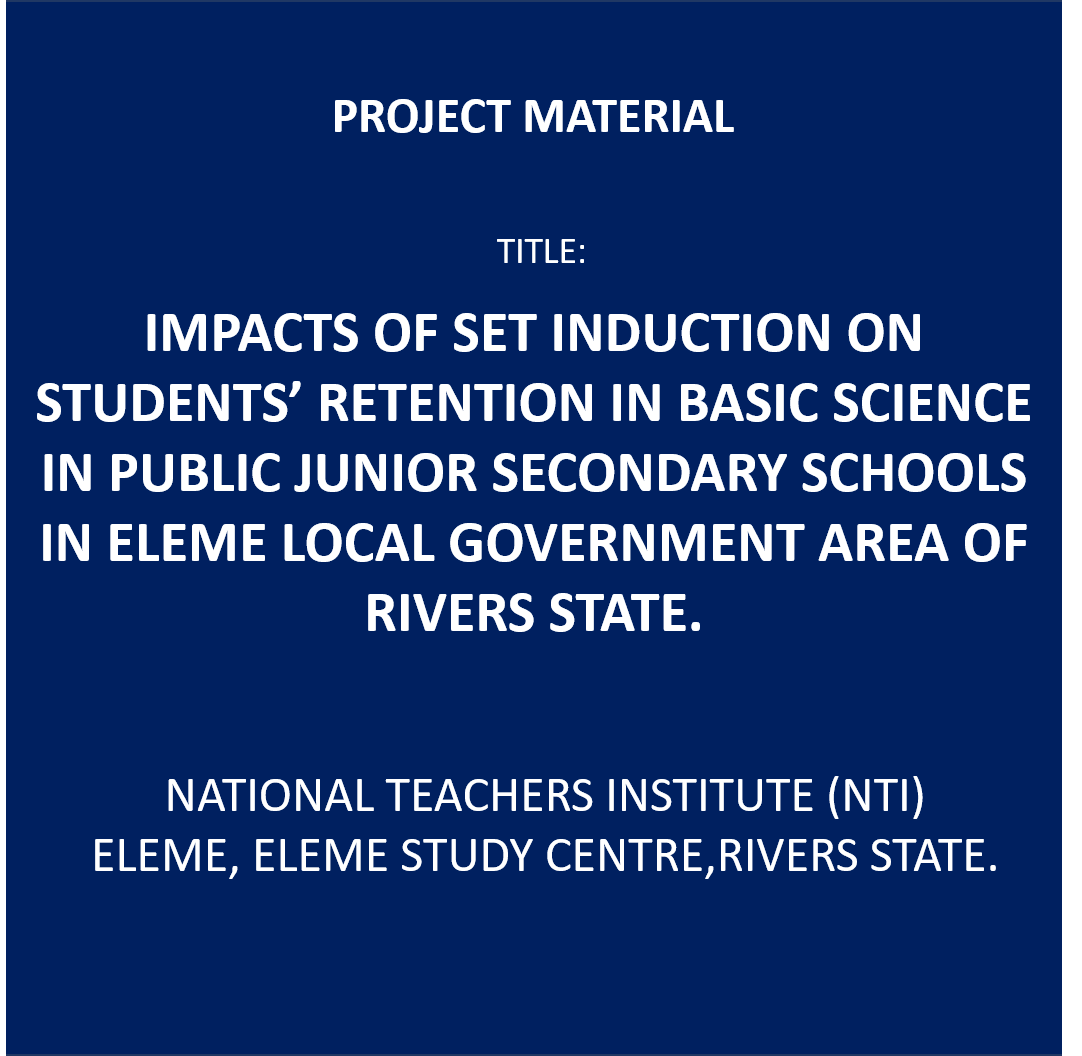No products in the cart.
Impact of Set Induction on the Teaching Of Basic Science in Public Junior Secondary Schools
₦10,150.00
ABSTRACT
This study investigated the impacts of set induction on students' retention in Basic science in public Junior Secondary schools in Eleme Local Government Area of Rivers State. In order to carry out this research work effectively, the Researcher put in great efforts to find out the impacts of using set induction in teaching. Two research questions were used for the investigation. The survey design was employed, using questionnaire as means for data collection. More so, various related materials were reviewed and summarized to develop a sound background of the study. The total population of the study comprised of 1500 students from five selected schools in Eleme Local Government Area. A sample size of 250 respondents were selected from the total population using random sampling technique. While the Simple percentage was used as Statistical tool for data collection and analysis. The findings were discussed, from the challenges or problems of using set induction to the impacts of set induction on students’ retention. Some of the challenges are; Lack of Qualified manpower, lack of materials, Lack of Students' interest, etc. However, there are positive impacts of using set induction, namely; for Students' Motivation, making the lesson interesting and easier to understand, etc. In Conclusion, relevant recommendations were outlined and will go a long way in promoting the effective use of set induction in teaching and learning.
Background of the Study
There have been a gradual shift from teachers’ centered to students’ centeredness in teaching and learning using educational instructions. This move according to Igboko and Ibeneme (2006), was informed by current world realities, such as globalization and rapid technological changes. To prosper in this modern age of innovations requires the capacity to grasp the essentials of diverse problems, recognize meaningful patterns and to retrieve and apply relevant knowledge (Adejoh and Idacha, 2010).
Science education has the potential to help in the development of the required abilities and understanding by focusing on ideas about the nature of the world, scientific activity and its applications.
To ensure knowledge construction which is needed in order to thrive in a world filled with scientific innovations, Owolabi (2007) affirm that Basic science has to be students centered, activity oriented and focused on understanding rather than memorization or rote learning.
Therefore, Basic science as seen by Secil and Hayriye (2013) is a fundamental component of Basic education that prepare students to live in a world increasingly defined by science and technology. Basic Science also utilized a problem-based and learning approach, which involves research and design development and application to the society (ITEA, 2001). Applying up-to-date knowledge obtained from Basic science creates opportunities for students to solve problems within their context, which could ultimately be applied to the global setting.
However, a challenge for Basic science and technology teachers is to capture the interests of the students on the subject matter from the beginning of the lesson. The use of set induction may help the teacher to gain the students attention from the early part of the lesson. A set induction is typically performed at the beginning of any effective lesson (Oman, 2001) and it allows the instructor to redirect the students’ attention and focus toward the objective of the lesson (Magruder, 2001).
It is an acceptable principle among educators that students cannot be forced to learn. However, the teacher or instructor can arrange conditions that will increase the probability of the motivation to learn becoming stronger, (Hunter 1995). These conditions are manipulated by educators using set inductions. According to Madeline Hunter (1995), the conditions that affect motivation include, concern, feeling, tone, interest, success, knowledge of results and extrinsic-intrinsic motivation.
– Concern deals with the amount of passion for a subject. This could make one to be anxious or excel in a subject. (Hunter 1995). Feeling tone deals with how something is said. This could have a positive, negative or neutral feel and could foster increased motivation based on how it is delivered.
– Interest is a condition that is acquired overtime, often due to exposure. It usually relates the meaning of the topic to the person and the outcome of different or unexpected results (Hunter, 1976).
– Success brings joy and confidence to students when experienced. Success comes with effort, and when success is achieved, motivation becomes the product (Hunter, 1995).
–Having knowledge of results allows students to strive for an even better outcome. That is, knowing what is done well and what can be improved motivates students when the results are given properly (Hunter, 1995).
– The last condition comes from intrinsic and extrinsic motivation. Intrinsic motivation occurs when the student is rewarded from doing the work itself. As a result, knowledge is gained. While extrinsic motivation is brought about by grades, social status, parental approval (Hunter, 1995).
Therefore, it is very important to understand the psychology of students when preparing set induction. Increased attention to a lesson does not result from what we do but rather how we do it (William Glasser, M.D 1997). He believed that our need for “power, freedom, fun and to belong” are the psychological motivations for what people want to do.
Fulfilling any of these needs is considered pleasurable, if not, learning becomes difficult. Students’ interests increase when the teacher gives them the choices of what and how to learn. When the lesson is presented by the teacher in a manner that invites students to learn instead of forcing them, the students will subconsciously select one of their needs to fulfill. These four needs; power, freedom, fun and to belong”, bring a higher level of motivation when engaged properly because everyone desires to meet them (Glasser, 1997).
Research supports that set-inductions have been used for several decades in educational settings. Studies also show that set inductions is an effective method of building students’ interest, and when an unexpected result occur, students exhibit the most interest in a topic.
Therefore, the research hypothesis for this study is that the use of set induction in Basic science would foster student’s interest and retention.

